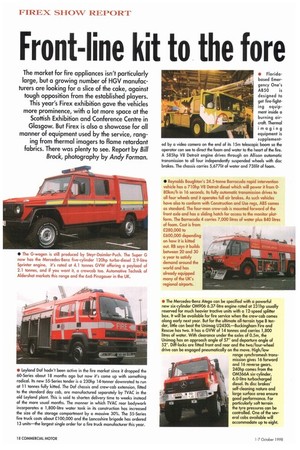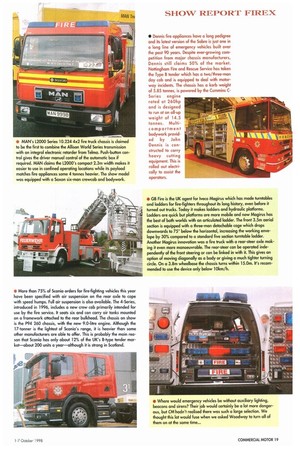Front-line kit to the fore
Page 20

Page 21

If you've noticed an error in this article please click here to report it so we can fix it.
The market for fire appliances isn't particularly large, but a growing number of HGV manufacturers are looking for a slice of the cake, against tough opposition from the established players. This year's Firex exhibition gave the vehicles more prominence, with a lot more space at the Scottish Exhibition and Conference Centre in Glasgow. But Firex is also a showcase for all manner of equipment used by the service, ranging from thermal imagers to flame retardant fabrics. There was plenty to see. Report by Bill Brock, photography by Andy Forman.
• Floridabased Emergency One's AB50 is designed to get fire-fighting equipment inside a burning aircraft. Thermal imaging equipment is supplemented by a video camera on the end of its 15m telescopic boom so the operator can see to direct the foam and water to the heart of the Fire. A 585hp V8 Detroit engine drives through an Allison automatic transmission to all four independently suspended wheels with disc brakes. The chassis carries 5,677Iit of water and 738Iit of foam.
• Reynolds Boughton's 24.5-tonne Barracuda rapid intervention vehicle has a 710hp V8 Detroit diesel which will power it from 080km/h in 16 seconds. Its fully automatic transmission drives to all four wheels and it operates full air brakes. As such vehicles have also to conform with Construction and Use regs, ABS comes as standard. The four-man crew-cab is mounted forward of the front axle and has a sliding hatch for access to the monitor platform. The Barracuda 4 carries 7,000 litres of water plus 840 litres of foam. Cost is from £280,000 to £600,000 depending on how it is kitted out. RB says it builds between 20 and 30 a year to satisfy demand around the world and has already equipped many of the UK's regional airports. • The G-wagen is still produced by Steyr-Daimler-Puch. The Super G now has the Mercedes-Benz five-cylinder 120hp turbo-diesel 2.9-litre Sprinter engine, it's rated at 4.1 tonnes GVVV offering a payload of 2.1 tonnes, and if you want it, a crewcab too. Automotive Technik of Aldershot markets this range and the 6x6 Pinzgauer in the UK. • The Mercedes-Benz Atego can be specified with a powerful new six-cylinder 0M906 6.37-litre engine rated at 231hp usually reserved for much heavier tractive units with a 12-speed splitter box. It will be available for fire service when the crew-cab comes along early next year. But for the ultimate all-terrain type B tender, little can beat the Unimog U24501—Buckingham Fire and Rescue has two. It has a GVW of 14 tonnes and carries 1,800 litres of water. With clearance under the axles of 0.5m, the Unimog has an approach angle of 57 and departure angle of 52'. Diff-locks are fitted front and rear and the two/four-wheel drive can be engaged pneumatically on the move. High/low range synchromesh transmission gives 16 forward and 16 reverse gears. 240hp comes from the 0M366A six-cylinder, 6.0-litre turbocharged diesel. Its disc brakes' self-cleaning nature and large surface area ensure good performance. For particularly soft terrain the tyre pressures can be controlled. One of the several cabs available will accommodate up to eight.
• Leyland Daf hadn't been active in the fire market since it dropped the 60-Series about 18 months ago but now it's come up with something radical. Its new 55-Series tender is a 230hp 14-tonner downrated to run at 11 tonnes fully kitted. The Daf chassis and crew-cab extension, fitted to the standard day cab, are manufactured separately by TVAC in the old Leyland plant. This is said to shorten delivery time to weeks instead of the more usual months. The manner in which TVAC rear bodywork incorporates a 1,800-litre water tank in its construction has increased the size of the storage compartment by a massive 30%. The 55-Series fire truck costs about £100,000 and the Lancashire brigade has ordered 13 units—the largest single order for a fire truck manufacturer this year. MAN's12000 Series 10.224 4x2 fire truck chassis is claimed to be the first to combine the Allison World Series transmission with an integral electronic retarder from Telma. Push-button control gives the driver manual control of the automatic box if required. MAN claims the L2000's compact 2.3m width makes it easier to use in confined operating locations while its payload matches fire appliances some 4 tonnes heavier. The show model was equipped with a Saxon six-man crewcab and bodywork.
• More than 75% of Scania orders for fire-fighting vehicles this year have been specified with air suspension on the rear axle to cope with speed humps. Full air suspension is also available. The 4-Series, introduced in 1996, includes a new crew cab primarily intended for use by the fire service. It seats six and can carry air tanks mounted on a framework attached to the rear bulkhead. The chassis on show is the P94 260 chassis, with the new 9.0-litre engine. Although the 17-tonner is the lightest of Scania's range, it is heavier than some other manufacturers are able to offer. This is probably the main reason that Scania has only about 12% of the UK's B-type tender market—about 200 units a year—although it is strong in Scotland. • Dennis fire appliances have a long pedigree and its latest version of the Sabre is just one in a long line of emergency vehicles built over the past 90 years. Despite ever-growing competition from major chassis manufacturers, Dennis still claims 50% of the market.
Nottingham Fire and Rescue Service has taken the Type B tender which has a two/three-man day cab and is equipped to deal with motorway incidents. The chassis has a kerb weight of 5.85 tonnes, is powered by the Cummins C Series engine rated at 260hp and is designed to run at an all-up weight of 14.5 tonnes. Multicompartment bodywork provided by John Dennis is constructed to carry heavy cutting equipment. This is rolled out electrically to assist the operators.
GB Fire is the UK agent for lveco Magirus which has made turntables and ladders for fire-fighters throughout its long history, even before it turned out trucks. Today it makes ladders and hydraulic platforms. Ladders are quick but platforms are more mobile and now Magirus has the best of both worlds with an articulated ladder. The front 3.5m aerial section is equipped with a three-man detachable cage which drops downwards to 75' below the horizontal, increasing the working envelope by 30% compared to a standard five section turntable ladder. Another Magirus innovation was a fire truck with a rear-steer axle making it even more manoeuvrable. The rear-steer can be operated independently of the front steering or can be linked in with it. This gives an option of moving diagonally as a body or giving a much tighter turning circle. On a 3.8m wheelbase the chassis turns within 15.0m. It's recommended to use the device only below 10km/h.
, Where would emergency vehicles be without auxiliary lighting, beacons and sirens? Their job would certainly be a lot more dangerous, but CM hadn't realised there was such a large selection. We thought this lot would fuse when we asked Woodway to turn all of them on at the same time...
















































































































